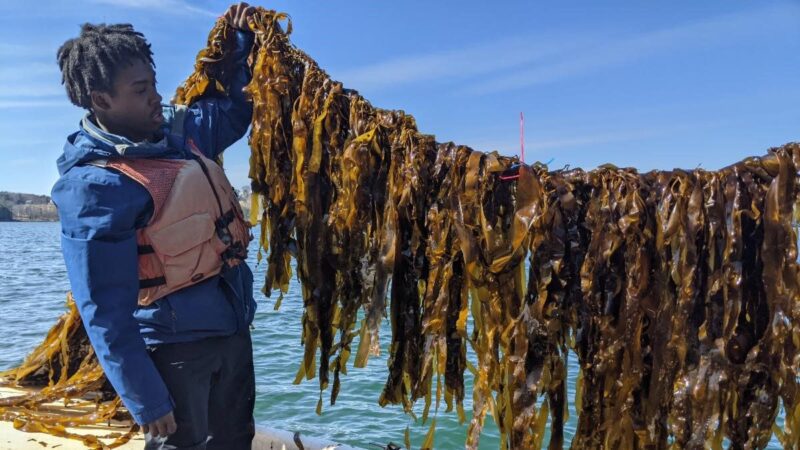Editor’s Note: The following story first appeared in The Maine Monitor’s free environmental newsletter, Climate Monitor, that is delivered to inboxes for every Friday morning. Sign up for the free newsletter to get important environmental news by registering at this link.
Researchers at the University of Maine have modeled what they say is the cheapest and most efficient way to store carbon in farmed kelp deep below the surface of the Gulf of Maine.
The new study, published recently in the journal Frontiers in Marine Science, offers a potential path forward for what some see as a crucial tool to pull the world back from the brink of climate catastrophe — but the fledgling field has a long way to go.
Kelp farming is a hot business in Maine — at the grocery store, you’ve probably seen products like fruit-flavored frozen kelp cubes from companies like Biddeford-based Atlantic Sea Farms, which got a glowing write-up this summer from The Washington Post’s climate and food desk.
The value of this “macroalgae” as a climate solution lies in the speed of its growth and its manner of decay. Kelp rapidly pulls carbon from the air through photosynthesis as it grows on rocky coasts like Maine’s — ecosystems that can store up to 20 times more carbon per acre than a land forest. This kelp gradually breaks down and drifts in bits out to the ocean and down into the depths, where it tends to remain undisturbed and unable to return to the atmosphere.
This process is what has kelp farming on the table as a potential carbon storage technique. In their new study, the UMaine researchers wanted to see what it would look like to do this at scale, with the most carbon stored at the least cost.
The model they devised involves farming kelp far offshore, then transporting it out even farther to “sink sites” in deep water. The carbon-rich kelp could be deposited in sediment more than 1,000 meters down, or sent “below the permanent thermocline” — the threshold where ocean water flips from warmer and well-mixed near the surface to cold and calm deep below — “in areas of the ocean where carbon is blocked from returning to the atmosphere,” UMaine says.
This approach would cut the cost of storing carbon in kelp from $17,048 per ton of greenhouse gas down to $1,257, the study says. But the university’s press release notes the industry target for any carbon storage technology to be “economically viable” is closer to $100 a ton.
Experts agree that the world is on track to need as many of these viable solutions as it can get. As businesses and governments continue to burn and use more fossil fuels, careening toward the goals of the Paris Climate Accords, it won’t be enough to just emit less — we’ll have to get rid of some emissions we already caused, using a range of methods of capture and storage.
These approaches include the nature-based (planting trees, restoring wetlands and grasslands, improving soil health on farms) to the heavy-industrial (sucking up carbon with giant fans and injecting it into deep-earth deposits of rock that can chemically bind to it) to the in-between (kelp farming and other biomass-based routes).
For kelp, as in most of these cases, many questions remain about environmental trade-offs.
“We just have zero experience with perturbing the bottom of the ocean with that amount of carbon,” University of California associate professor Steven Davis told MIT Technology Review last year. “I don’t think anybody has a great idea what it will mean to actively intervene in the system at that scale.”
And there are practical considerations. Maine’s coastal communities are famously skeptical about many forms of industrial aquaculture — see ongoing debates about fish farming — and other ocean users, such as lobster fishermen, have balked at the idea of offshore wind turbines.
What response could we expect, then, to farming kelp offshore and burying it deep at sea?
To read the full edition of this newsletter, see Climate Monitor: Storing carbon in kelp, plus PFAS and the Penobscots.
Annie Ropeik has been given the keys to the Climate Monitor newsletter while its regular author, the Monitor’s environmental reporter Kate Cough, is on leave until November. Reach Annie with story ideas at: aropeik@gmail.com.





